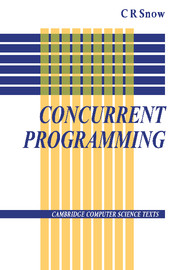Book contents
- Frontmatter
- Contents
- Preface
- 1 Introduction to Concurrency
- 2 Processes and the Specification of Concurrency
- 3 Communication between Processes
- 4 High-Level Concurrency Constructs - Shared Data
- 5 High-Level Concurrency Constructs - Message Passing
- 6 Languages for Concurrency
- 7 Implementation of a Concurrency Kernel
- Bibliography
- Index
4 - High-Level Concurrency Constructs - Shared Data
Published online by Cambridge University Press: 05 June 2012
- Frontmatter
- Contents
- Preface
- 1 Introduction to Concurrency
- 2 Processes and the Specification of Concurrency
- 3 Communication between Processes
- 4 High-Level Concurrency Constructs - Shared Data
- 5 High-Level Concurrency Constructs - Message Passing
- 6 Languages for Concurrency
- 7 Implementation of a Concurrency Kernel
- Bibliography
- Index
Summary
In the previous chapter we considered the basic problem of communication between processes, and reduced it to the problem of preventing two processes from accessing the same shared resources simultaneously. It should be clear that from such mechanisms it is possible to construct a large number of different methods for communication. It is also clear that the relationship between the lowlevel mechanisms described in the previous chapter and the higherlevel constructs is similar to the relationship between a low-level assembly language program and the corresponding program in a highlevel language; the first provides a basic mechanism, which clearly is sufficient, if inconvenient, to implement all the necessary synchronisation. The second expresses the solution to the problem in a much more “problem oriented” fashion.
In this chapter we shall consider a number of high-level constructs which have been proposed which allow a more structured approach to many inter-process communication/synchronisation problems. In the same way that the use of high-level languages allows the programmer to express his algorithms in a more natural way, and hence will make the inclusion of simple logical errors less likely, so the use of high-level synchronisation constructs in concurrent programs will also tend to reduce the incidence of elementary concurrent programming errors.
To take a small example, consider program 4.1, which uses binary semaphores to provide an implementation of the critical section problem (c.f. program 3.12).
Information
- Type
- Chapter
- Information
- Concurrent Programming , pp. 78 - 112Publisher: Cambridge University PressPrint publication year: 1992
